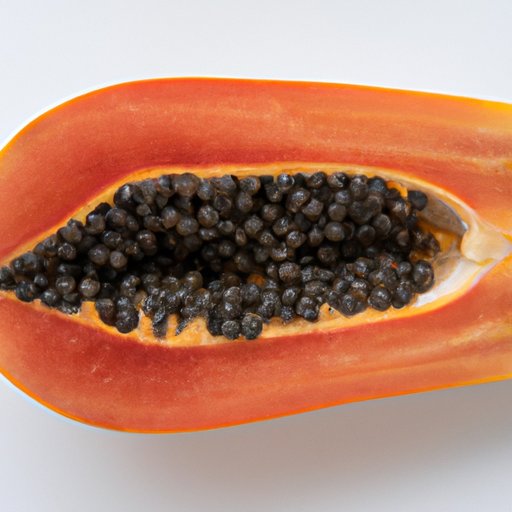Introduction
If you’re a tropical fruit lover, you may have come across papayas. This succulent fruit has a unique taste and texture that sets it apart from other fruits. However, choosing the right papaya can be tricky. It’s important to know how to tell if a papaya is ripe for the best flavor and texture. In this article, we’ll explore how to identify a ripe papaya using visual cues, texture, and smell. We’ll also discuss the nutritional benefits of this superfood.
Why Selecting a Ripe Papaya is Important
Choosing a ripe papaya is essential for getting the best flavor and texture from the fruit. A ripe papaya is sweeter, juicier, and more fragrant than an unripe one. Additionally, unripe papayas are harder and less flavorful. Evaluating the ripeness of a papaya before eating it is crucial to experience the full benefits of this fruit.
Papayas are nutrient-dense fruits that are rich in vitamins C and A, potassium, fiber, and antioxidants. By eating ripe papayas, you’ll get more nutrients and healthful benefits, including boosting your immune system and promoting healthy vision.
Visual Cues of a Ripened Papaya
One good way to tell if a papaya is ripe is to look at its color. Papayas start out green, but as the fruit matures, it changes color. A ripe papaya typically has a golden yellow or orange-red color. If the papaya is still green, it is unripe.
Another visual cue to look for in a ripe papaya is the texture of the skin. Wrinkled skin on a papaya is a sign that it is fully ripe. A ripe papaya may also have black or brown spots on the skin, which is the natural effect of ripening.
How a Ripe Papaya Feels
In addition to visual cues, feeling a papaya can help determine its ripeness. A ripe papaya will be soft to the touch. You’ll know it’s ripe if it slightly yields when you apply pressure with your hands. If it feels firm, it’s not yet ripe. However, be careful not to apply too much pressure, as it may bruise the fruit.
Tips for Checking the Ripeness of a Papaya
The best way to check if a papaya is ripe is by smelling it. If it has a sweet and fruity aroma, it’s likely ripe. However, if it has no fragrance, it’s probably not yet ripe.
You can also press the top of the papaya stem. If it feels soft, the papaya is ripe. If it feels hard, the papaya is not yet ripe.
Finally, be sure to take note of any changes in the skin’s color and texture. As the papaya ripens, the fruit will become more fragrant, sweeter, and softer, making it easier to peel and eat.
Storing Ripe Papayas
Ripe papayas should be stored in the refrigerator. They’ll stay fresh for about a week if stored in a cool and dry place. You can also store unripe papayas at room temperature until they turn soft and yield to pressure.
Avoid storing papayas near other fruits and vegetables, as they will quickly spoil. You can also freeze ripe papayas for later use by cutting them into slices or chunks and placing them in an airtight container.
Conclusion
Choosing a ripe papaya is crucial to ensure you’re getting the best taste, texture, and nutritional benefits. Remember to look for the visual cues, check the texture, and smell the fruit to determine its ripeness. Experiment with different ways of preparing ripe papayas by adding them to smoothies, salads, or eating them as a healthy snack. By following these tips, you can enjoy the full benefits of this tropical fruit.
